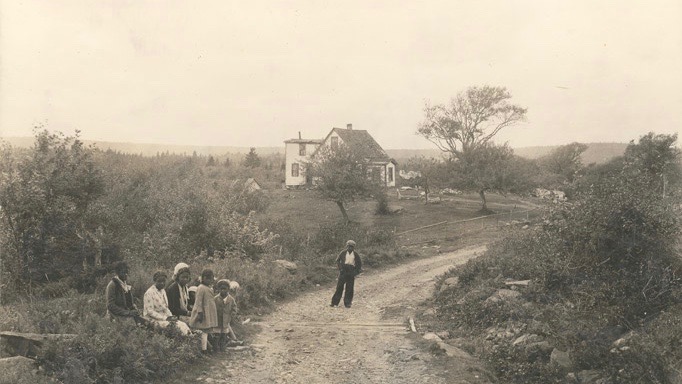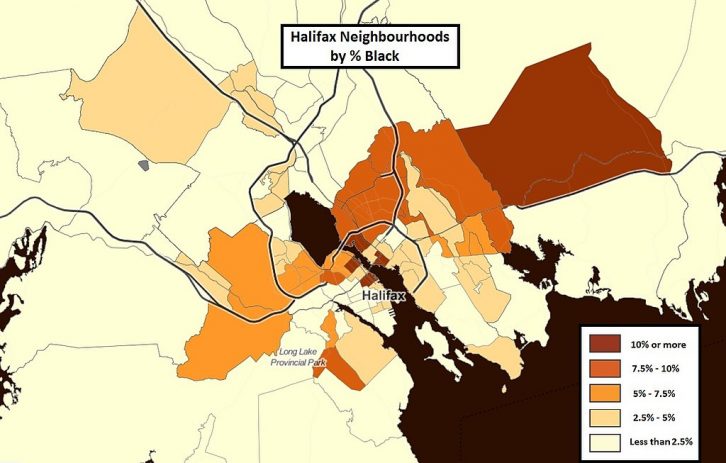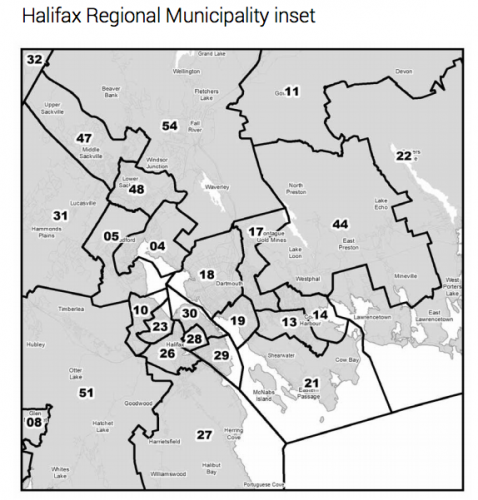Representation
Will redrawing the electoral map improve African-Nova Scotian representation?
Senator says reinstating the Preston boundary no simple solution

caption
A home and group of children in North Preston. Photographed by Gauvin & Gentzel, 2 October 1934.African-Nova Scotians are fighting for better representation in provincial government.
Since March, the body responsible for determining the province’s electoral boundaries has been on the hunt for ways to give Acadian and African-Nova Scotian populations more of a voice.
Their latest solution is to redraw boundaries of select districts in hopes of giving marginalized groups a chance to elect a member of their own community.
But for the African-Nova Scotian community, this might not make a difference. Related stories
In an interim report released in November, the commission recommended to re-establish four protected ridings eliminated by the NDP government in 2012. Three of these ridings — Argyle, Clare and Richmond — are predominantly Acadian communities. Only one riding, Preston, is predominantly black.
In January, the commission set out on a provincial tour to gather feedback on the recommendations. At a meeting in Cherrybrook on Jan. 15, speakers told the commission that redrawing the boundaries would not be enough to ensure black representation in the legislature.
Nova Scotia Sen. Wanda Bernard, who represents the Preston area in federal senate, agrees.
“None of those ridings actually have enough black folks to win the seat for a black candidate,” she says. “That will never happen.”
The key, she says, is to look at the individual needs of each community.
“The boundary redrawing does not guarantee anything for African-Nova Scotians, but it does for Acadians,” she says. “The realities are different; we need to just name that.”
Different histories
In 2002, the commission determined high concentrations of Acadian populations lived in Clare, Argyle and Richmond. The report determined 70 per cent of residents in Clare and 54 per cent in Argyle spoke French as their mother tongue.
The African-Nova Scotian community, the report concluded, was concentrated in Halifax County, spread between Preston and the north end area of Needham.
In reality, says Bernard, the black community is much more dispersed. Black people settled in over 50 communities across the province — from Digby to Whitney Pier.
“The reality is African-Nova Scotians were not meant to survive in those communities,” says Bernard. “They’re smaller; they’re all on the fringes of white towns and so none of those communities, with the exception of Preston, have any significant numbers.”
According to Statistics Canada’s 2016 census, there are nearly 22,000 black Nova Scotians, two-thirds of whom live in Halifax subdivisions and places like Hammonds Plains, Cherrybrook and Lucasville.
The Preston riding stretches from Lake Echo to Westphal, but does not have enough black residents to make the majority of the vote. Census data from 2016 suggests black voters make up only one-fifth of Preston electors.

caption
Percentage of population that identify as black by the Halifax census tract, according to 2016 data.The Preston riding’s first MLA, Wayne Adams, was elected in 1993. He says when the riding was first created, the goal was to unite communities with shared specific needs and interests. The original Preston shared concerns like the environmental impact of nearby dump development.
“We had common interests among those semi-urban, semi-rural communities,” he says. “The person elected never had a real tough job. Because he had common interests in that circle.”
Adams and his successor, Yvonne Atwell, each served one term. Atwell lost her seat to David Hendsbee in the 1999 election. The Preston riding has not had a black representative since.
In fact, since Atwell, there have been few black representatives in the legislature. Percy Paris held the Waverley-Fall River-Beaver Bank seat from 2006 to 2013, while Stephen Gough held Sackville-Beaver Bank from 2013 to 2017. Tony Ince was elected to Cole Harbour-Portland Valley in 2013; he still has his seat.
Member-at-large
Colin Dodds, chair of the electoral boundaries commission, says he knows protected ridings haven’t always worked.
“Typically the Acadians have had more success than say Preston,” he says.
In response, he says this year’s commission recommends expanding Preston’s boundaries beyond the lines drawn in 2002. They hope the change will give African-Nova Scotians more voting power.

caption
A proposed electoral map for the HRM , which includes the new boundary lines for the Preston district (44).The interim report also briefly explores the introduction of an at-large representative for African-Nova Scotians across the province.
“The argument for it is that those particular constituency populations are spread right across Nova Scotia,” says Dodds. “If you could create a seat it would give those dispersed centres of minority populations more effective representation in theory.”
Ultimately, the commission decided not to recommend the extra seat. Despite some interest at community meetings, Dodds says the public was concerned one representative couldn’t capture the diverse needs of black voters in different regions of the province.
“That’s highly impossible, to be effective representation as one person elected for every black Nova Scotian,” says Adams. “That’s a pretty diverse individual, an extremely diverse individual.”
A multi-faceted approach
Bernard says an at-large representative would only be part of the solution. She recommends a multi-faceted approach that would include the member-at-large seat, reinstating the Preston riding and, most importantly, calling on the individual parties to introduce employment equity.
“We should not have one voice for African-Nova Scotians in the legislature, so another solution to that would be each party only running African-Nova Scotians,” says Bernard. “I would say that every party should be looking at strategies to increase representation of different cultural groups across the province.”
In 1992, says Adams, the commission was looking to guarantee a black seat in the legislature.
“There’s no way to guarantee that unless all three parties run black candidates,” he says. “They’ve got to recruit them as members of their parties.”
Adams and Bernard both acknowledge the parties are responsible for pushing for equity in provincial government.
“Is it not time for us to have more representation? Not just of African-Nova Scotians, but other ethnocultural groups as well around the province,” says Bernard. “That only happens if the parties are identifying and supporting and mentoring people to run for office.”
Bernard missed the January round of public meetings, but plans to send a written submission to the commission outlining her suggestions for effective representation.
The commission’s final report, and its final recommendation, is due to be presented in April.

K
Kevin Murphy
T
Terra Tailleur